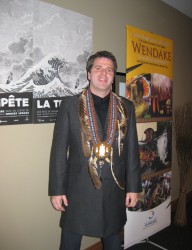Article Origin
Volume
Issue
Year
Internationally-acclaimed director Robert Lepage chose to stage his 2011 production of William Shakespeare’s classic play The Tempest this July at the outdoor amphitheatre in charming Wendake, home of the Huron-Wendat nation.
Lepage is a world-class playwright, actor, and film and stage director, one of Canada’s most honored theatre artists, whose work includes producing Richard Wagner’s second Ring opera Die Valkyrie at the New York MET to great acclaim this spring.
He is also close to the Huron-Wendat community.
“We were very proud and privileged that Robert Lepage… presented a show here that gave positive impacts for the community,” said Konrad Siouï, grand chief of the Huron-Wendat Nation who calls Lepage a friend and neighbour.
Lepage’s Tempest was not Shakespeare’s play, but rather an adaptation of it, in which Prospero becomes the White colonizer of the island while Caliban and the spirits that inhabit the island are oppressed Amerindians,” commented Champlain-St.Lawrence College teacher John Hart Whitt, who specializes in Shakespeare.
“There is nothing unusual in Lepage’s adapting the play so as to serve his own purposes, as most directors do the very same thing, to varying degrees and for different reasons, when they stage one of Shakespeare’s plays,” Whitt said.
“It is easily done: It suffices to omit certain passages, to change the context (and hence the meaning) of others, and to add appropriate stage business. Lepage uses all three of these techniques very effectively to turn The Tempest into a postcolonial play.”
Lepage altered the epilogue, said Whitt. “Prospero addressed not the audience, but Caliban. He gave the end a postcolonial twist whereby the new settlers, represented by Prospero, sought forgiveness from the First Nations they encountered in the New World. By means of this change and others, Lepage transformed Shakespeare’s Caliban and Prospero,” Whitt said.
The director included First Nations actors, regalia and language. Huron-Wendat Steeve Wadohandik Gros-Louis played King Alonso of Naples and his internationally renowned dance troupe, Sandokwa, was central to the production.
Lepage’s Ariel was brought to life by Kathia Rock, an Innu from Maliotenam, and Wendat Jean-Francois Faber also performed in the play.
This was not Lepage’s first experience using First Nations’ culture to inspire his work. He came to a powwow in 2009, created a unique canoe show and produced Totem with the Cirque du Soleil in 2010.
Lepage wished “to focus more on the story of the European man (Prospero) who finds refuge on an island, becomes master of it, and then uses its culture to serve his own purpose of revenge.” Lepage planned to give greater importance to the First Nations without being “too politically correct.”
He was also inspired by a Joseph Légaré painting that depicts Edmund Kean, a famous English actor, performing Shakespeare in Wendake in the 1800s. Kean was much admired by the Hurons who made him an honorary chief and gave him the name “Alanienouidet,” meaning “strong wind in drifting snow.”
Lepage brought that historic alliance back to life.
What was it like to work with the renowned Robert Lepage? According to Huron-Wendat artist Gros-Louis, “Robert Lepage is very calm… remarkably calm, and very open-minded, which made it easy to work with him.” Gros-Louis was accompanied on stage by his eleven-year-old son, Dewatha, and his eight-year-old daughter, Keyara.
“It was an honor to work with Robert Lepage,” said Gros-Louis who was pleased to be called by the director for a role in the play. Gros-Louis felt that the challenge to the production was how Lepage would put the Huron-Wendat touch into the play.
Spectators received a well-illustrated program with Innu translations of Ariel’s songs, paintings from Huron-Wendat history and the story of Edmund Kean, who inspired Lepage.
Photo Caption top: Prospero witnesses his daughter Miranda falling in love with Ferdinand in Lepage’s adaptation of Shakespeare’s The Tempest staged in Wendake.
Photo: Renaud Philippe
Photo Caption bottom: Huron-Wendat Steeve Wadohandik Gros-Louis both played Lepage’s adaptation of King Alonso and also danced in traditional Huron-Wendat scenes.
Photo: Marie White
- 6655 views


